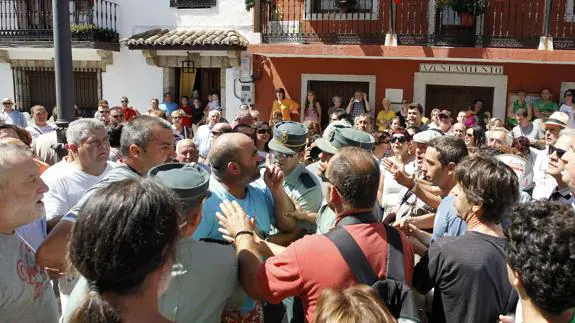Haunted by the past
Giles Tremlett (b. 1962). Ghosts of Spain: Travels Through a Country’s Hidden Past (2006 & 2012)
Mark Nayler
Martes, 17 de enero 2017, 09:12
Spains political landscape is about to undergo titanic shifts. Last Sunday, the coalition of separatist parties in Catalonia, Together for Yes, won a majority in the regions parliamentary elections, and the imminent general election will see the dominance of Spains two main parties threatened for the first time in the countrys recent history. Now is the perfect time, therefore, to read Ghosts of Spain, British journalist Giles Tremletts magisterial work on Spanish politics, history and culture and Spains agonised relationship with its own past.
Tremletts book - powered by a forensic curiosity and written in flowing, addictive prose - deals with most aspects of Spanish culture: flamenco, football, attitudes towards women and family, the fascinating dichotomy of anarchy and individualism versus order and tradition, regional differences and Spains status as a tourism superpower are all discussed with first hand knowledge and understanding. But, as the books subtitle suggests, at its heart is an investigation into the legacy of Spains devastating civil war and its transition, after Francos death in 1975, to democracy - ironically pioneered by a king who Franco himself appointed as his successor.
Tremlett travels the length and breadth of Spain to reveal a country that, despite - or perhaps because of - its 1977 amnesty and associated pact of forgetting, is still divided and troubled by its civil war and ensuing 39-year dictatorship. The internal damage wrought by the conflict was catastrophic: by the time it ended in 1939 - when Franco took power, thus bringing Spains Second Republic to an end - half a million Spaniards, including one in thirty Spanish men, had lost their lives, and around 400,000 were in exile.
The central point around which Tremletts book revolves is his discovery, in the early years of the twenty first century, that the sores of the Spanish Civil War . were still there, untended and only partially cured.
The village of Poyales del Hoyo in Ávila, where a local elderly woman named Obdulia recounts to him the horrific events of 29 December 1936, is at the centre of Tremletts investigation. It was on this night in Poyales that Obdulias mother, Pilar Espinosa, and two other local women, Virtudes de la Puente and Valeriana Granada (then pregnant) were denounced as Republicans by a fellow villager. They were dragged from their homes late at night by a gang of the local fascist Falange, driven out into the countryside, murdered, and thrown into a ditch by the road. There they lay until All Saints Day in 2002, when Tremlett arrived to hear the extraordinary story of locals efforts to give the three women a dignified burial, despite the fierce opposition or casual indifference of other residents, 66 years after their murder.
The residents of Poyales had been inspired by the example of Emilio Silva, who exhumed his grandfathers unmarked grave in Priaranza del Bierzo 15 years ago and who then went on to lead the Association for the Recovery of Historical Memory in Spain (ARMH). When Tremlett interviewed Silva in Madrid in 2011, after revisiting an only slightly changed Poyales, he learned that the movement had helped to exhume around 5,500 bodies of Francos victims from 280 unmarked ditches like the one in which Pilar, Virtudes and Valeriana were dumped. In January this year, the ARMH was awarded an ¤829,000 ($100,000) human rights prize by the Abraham Lincoln Brigade Archives and the Puffin Foundation in New York for further exhumations.
That Obdulia remembers the night of her mothers execution in such vivid detail provides us with a harsh reminder of just how recently the Spanish civil war occurred. But despite being within - deeply traumatic - living memory for many Spaniards, discussion and knowledge of the conflict and its repercussions is still, Tremlett writes, shied away from within communities, often entirely absent on school curriculums, and passionately opposed by varying political factions.
Spains pact of forgetting was ratified, by both right and left wing parties, in the 1977 Amnesty Law; it constituted an agreement not to mention, in public or private discourse, the war itself, and not to try and seek out the perpetrators of terrible crimes or mourn openly for their victims, even if they could be identified. It was and is seen by many Spaniards, desperate to move away from this terrible epoch of their history, as the reluctantly-accepted condition of a smooth transition to democracy.
Tremlett convincingly shows that this amnesty was effectively an agreement to collective amnesia, an amnesia that is still prevalent in Spain. It has meant that no one in Francos rebel army, nor on the Republican side, has ever been put on trial for crimes against humanity. The tragic corollary of that is unknown numbers of murdered Spaniards languishing in anonymous oblivion for decades, their families denied knowledge of how or where their loved ones died.
The struggle of Poyales residents to bury their dead ceremonially, and to hold guilty individuals to account, is of course deeply moving on a human level; but it is also symbolic of Spains struggle as a whole to come to terms with its civil war and to what its countrymen did to one another. With seismic political changes on the horizon in Spain, it might well be that this struggle is entering a new stage of its tortuous journey. Tremletts book has never been more relevant.
